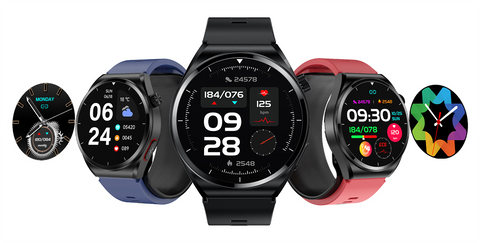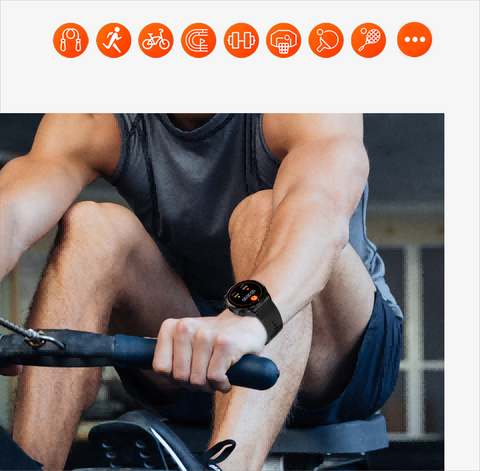Comment fonctionnent les capteurs des trackers d’activité et des montres intelligentes ?
Les objets connectés, comme les trackers d'activité et les montres connectées, sont devenus des incontournables de la vie moderne. Ces appareils offrent une gamme de fonctionnalités, notamment le suivi de l'activité, la surveillance du sommeil, des informations sur la santé, des notifications et des alertes d'urgence. La réalisation de ces fonctionnalités repose principalement sur des capteurs et des puces intégrés.

L'anatomie d'une montre connectée
Une montre connectée est composée de nombreux petits composants, principalement divisés en deux parties : le boîtier de la montre et le bracelet. Le bracelet peut être fabriqué à partir de divers matériaux, tandis que le boîtier abrite des éléments électroniques essentiels : capteurs, puces, batteries, écrans tactiles, affichages, etc. Contrairement aux montres traditionnelles, les fonctionnalités d'une montre connectée proviennent de ces composants électroniques intégrés.
Malgré leur taille compacte, les montres intelligentes peuvent accueillir de nombreux modules fonctionnels, notamment des cartes radiofréquence, des cartes Bluetooth, des cartes WiFi, des cartes de gestion de l'alimentation et divers capteurs.
Principaux capteurs des montres intelligentes
Les montres connectées utilisent plusieurs capteurs pour offrir des fonctionnalités de surveillance de la santé et de suivi des activités. Voici les sept types de capteurs les plus courants que l'on retrouve dans les montres connectées actuelles :
- Accéléromètre
- Moniteur de fréquence cardiaque
- Capteur SpO2
- Capteur de température de la peau
- Capteur ECG
- Gyroscope
- GPS
Accéléromètre
L'accéléromètre est l'un des capteurs les plus répandus dans les montres connectées. Il mesure l'accélération, c'est-à-dire le taux de changement de vitesse. Il peut détecter si l'utilisateur est en mouvement, ce qui en fait une fonction standard dans toutes les montres connectées. Par exemple, les accéléromètres suivent les pas, la distance et les calories brûlées en détectant les mouvements. Ils mesurent les niveaux d'activité pendant divers exercices comme la course et la marche.
De plus, les accéléromètres aident les montres connectées à déterminer leur orientation par rapport à la gravité terrestre, ce qui permet d'orienter correctement l'affichage. Par exemple, lorsque l'utilisateur lève son poignet, le cadran de la montre s'illumine.
Moniteur de fréquence cardiaque
Le moniteur de fréquence cardiaque (HRM) est un capteur essentiel des montres connectées modernes, conçu pour détecter et mesurer la fréquence cardiaque et le pouls de l'utilisateur. La plupart des montres connectées utilisent la technologie de photopléthysmographie (PPG) à cette fin. La PPG est une méthode non invasive qui utilise des sources de lumière LED pour éclairer la peau et des capteurs optiques pour détecter les changements de lumière réfléchie, mesurant ainsi le flux sanguin et calculant la fréquence cardiaque.
Les cardiofréquencemètres fournissent des données de fréquence cardiaque en temps réel et surveillent les variations de fréquence cardiaque pendant l'exercice, aidant ainsi les utilisateurs à ajuster l'intensité de leur entraînement. La surveillance à long terme de la fréquence cardiaque permet aux utilisateurs de comprendre les tendances et de détecter rapidement les problèmes de santé potentiels.
Capteur SpO2
Les capteurs SpO2 mesurent la saturation en oxygène du sang, c'est-à-dire le pourcentage d'hémoglobine transportant l'oxygène dans le sang. Ils utilisent la lumière rouge et infrarouge pour éclairer la peau et mesurer les niveaux d'oxygène en fonction de l'absorption de la lumière. L'hémoglobine oxygénée absorbe plus de lumière infrarouge et moins de lumière rouge, tandis que l'hémoglobine désoxygénée absorbe plus de lumière rouge.
Les capteurs SpO2 sont essentiels pour la surveillance de la santé respiratoire. En surveillant les niveaux d'oxygène dans le sang, les utilisateurs peuvent détecter des maladies respiratoires telles que la bronchopneumopathie chronique obstructive et l'apnée du sommeil. Les athlètes peuvent également utiliser ces capteurs pour surveiller les effets de l'entraînement et assurer un apport en oxygène adéquat pendant les séances d'entraînement intenses.

Capteur de température de la peau
Les capteurs de température cutanée mesurent l'énergie thermique émise par la surface de la peau, reflétant les changements de température corporelle qui peuvent indiquer divers problèmes de santé ou réactions environnementales. Les montres intelligentes équipées de capteurs de température cutanée surveillent en permanence les changements subtils de température, facilitant ainsi la détection précoce des maladies.
Ces capteurs permettent non seulement de suivre la température corporelle quotidienne, mais également de fournir des données en temps réel pendant les activités physiques. Les montres intelligentes avancées utilisent des capteurs de température cutanée pour le suivi de la santé féminine, notamment la prédiction des règles et la gestion du cycle de fertilité.
Capteur ECG
Les capteurs d'électrocardiogramme (ECG) mesurent l'activité électrique du cœur, capturant de minuscules signaux électriques produits par chaque battement de cœur. En enregistrant et en analysant ces signaux, les capteurs ECG détectent les irrégularités du rythme cardiaque et d'autres problèmes cardiaques. Les montres connectées équipées de capteurs ECG permettent de surveiller l'activité cardiaque en temps réel, aidant ainsi les utilisateurs à comprendre leur santé cardiaque.
Les capteurs ECG, associés à d'autres capteurs comme les cardiofréquencemètres, offrent des données complètes sur la santé cardiaque. La surveillance cardiaque continue aide les utilisateurs à détecter les irrégularités de manière précoce et à prendre les mesures nécessaires.
Gyroscope
Les gyroscopes mesurent l'angle et la vitesse angulaire d'un objet, fournissant ainsi des données sur les changements de direction. Ils sont souvent utilisés avec des accéléromètres pour améliorer la précision de positionnement des montres connectées. Les gyroscopes détectent la rotation et l'inclinaison, offrant ainsi des données de mouvement précises.
Par exemple, les gyroscopes détectent diverses activités physiques (course à pied, vélo, natation) et fournissent des données de mouvement précises. Ils sont également utilisés dans les applications de réalité augmentée (AR) pour détecter avec précision la direction et le mouvement.

GPS
Les capteurs du système de positionnement global (GPS) utilisent des signaux satellites pour déterminer l'emplacement précis de l'appareil et suivre les mouvements. Ils permettent de compter les pas avec précision, de tracer des itinéraires pour la course à pied et le vélo, et de suivre les activités en détail. Les capteurs GPS calculent les positions géographiques en recevant des signaux satellites et en fournissant des données de mouvement précises.
Les montres connectées équipées de capteurs GPS permettent aux utilisateurs d'enregistrer les itinéraires d'exercice, de proposer une navigation en temps réel et de fournir une analyse détaillée de l'exercice. Cependant, la fonctionnalité GPS nécessite une bonne réception du signal et peut réduire la durée de vie de la batterie.
Conclusion
Les montres connectées ont révolutionné la surveillance de la santé grâce à une technologie de capteurs avancée. À mesure que les capteurs et les technologies associées évoluent, les montres connectées continueront d'offrir des fonctionnalités de surveillance de la santé et de suivi des activités plus sophistiquées.
En combinant différents capteurs, les montres connectées fournissent des informations complètes sur la santé, améliorant ainsi la qualité de vie globale. Grâce à une innovation continue, l'avenir de la technologie des montres connectées est prometteur, ouvrant de nouvelles possibilités pour le suivi de la santé et de la condition physique.












